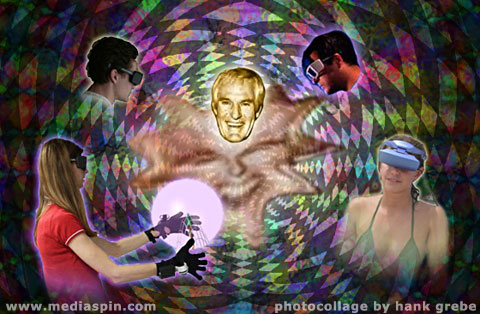Animation &Book Review &Media SpinMeister on 08 Jul 2006 12:55 pm
Timothy Leary’s Virtual Reality
A recent New Yorker book review of Robert Greenfield‘s biography of Timothy Leary, aptly titled, Timothy Leary: A Biography, got me thinking about when I saw Leary speak at a computer graphics conference.
SIGGRAPH 1990 could have been virtually anywhere. As the primary conference for computer graphics and interactive techniques, since its first meeting in Boulder, CO, 1974, it’s a pixel pow-wow, a gathering of minds comparing their renderings and notes. My first SIGGRAPH was 1983 in Detroit, not long after the movie TRON was released. I had worked in traditional animation in the 70’s with Steven Lisberger and Eric Ladd in Boston. Taking breaks from tedious hand rendered in-betweening, inking and painting chores, we wondered when computers might come to our rescue. SIGGRAPH was the tribe with the best possible solutions.
So, SIGGRAPH90 was pretty amazing, because computer graphics had advanced into Hollywood’s visual effects, and the world was buzzing about the potential of a big new mind blowing idea: Virtual Reality. VR promised to take elements of what SIGGRAPH CSE’s did best: 3D graphics and intractivity, and enable “realities built for two.” But the truly amazing part was a panel session including Timothy Leary, “Hip, Hype and Hope: The Three Faces of Virtual Worlds.” This link provides a PDF of the entire transcript and some slides from that exciting event.
Even though Timothy Leary had been far ahead of the curve in his explorations of expanded consciousness through LSD, it was refreshing to me as a graphic designer and devotee of Marshall McLuhan to hear Leary speak this way…
“I’d like to make a comment about SIGGRAPH. I’ve not been a regular visitor to these conferences. To tell you the truth, I’m such a slow learner, it took me a long time to figure out that graphics are the key to the whole communications business. The key to the new global language.
Then I recalled the advice of a great prophet who had been babbling to me for years about graphics! Graphics! Graphics!
I am talking about Ted Nelson who patiently tutored me about the importance of eye-balling and rendering and optical realities. I thank you for that, Ted.
During that talk, Leary nearly coined the name iPod:
“But the eye is the pod of the naked brain. It’s spooky when you think of it. We walk around with our moist binocular brains bulging out of our faces.”
Because Leary was not a computer graphics geek or a VR advocate, he added a charming simplicity and unpretentiousness to the panel of sophisticates. Professional turf wars arose during the Q & A session, when Myron Kruger and one of his buddies pitched their pioneering ownership of VR under the name artificial reality. The incident is included in the panel PDF transcription, and is one of those cases of a disgruntled creative coming to grips with what might be called traction. Myron’s term artificial reality did not catch on, and virtual reality somehow captured the zeitgeist of the idea. Imagine the frustration of someone claiming to have invented Google 15 years ago, but gave it an unattractive name like fistulinks or altavista. Ew!
The New Yorker article is an excellent read, and is a fine reminder of Leary’s trippy times, in which he hoped to solve the world’s problems by coaxing our leaders to drop acid. Perhaps today they could fight out their conflicts through a VR interface into a Massively Multiplayer Online Role-playing Game (MMORPG). Far out man!
Additional related readings and listenings:
Erowid Timothy Leary Vault
A recent article by Jaron Lanier
The RU Sirius Show, If You Meet Timothy Leary by the Side of the Road
Timothy Leary: A Biography

